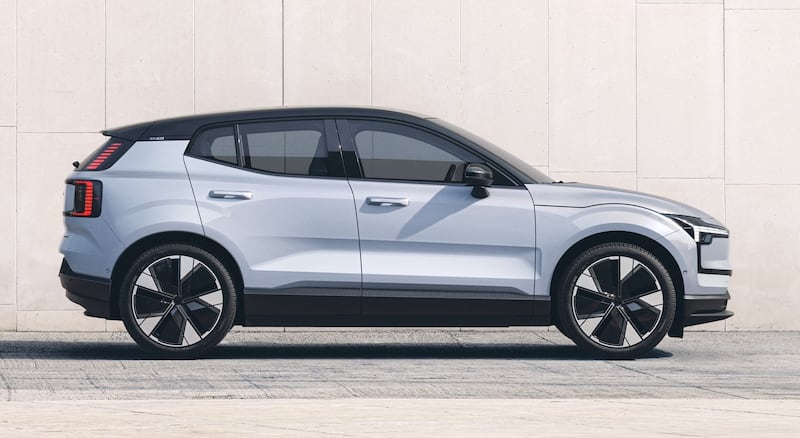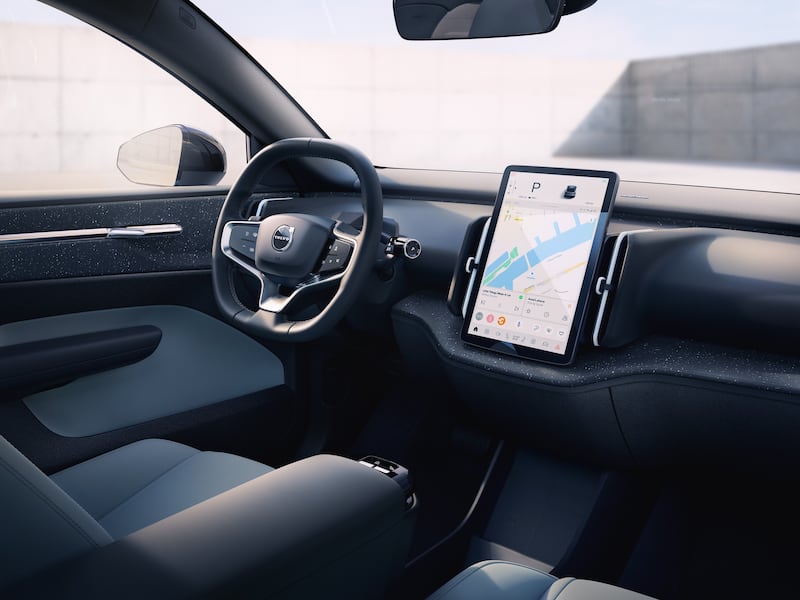Perhaps this is finally the predictions of electric cars reaching down to match the prices of combustion cars coming true. Or maybe it’s just the mind-numbing effects of the cost of living crisis resetting what we think to be affordable, but the new Volvo EX30 is going to arrive in Ireland later this year with a surprisingly small price tag.
Well, we say ‘small’. What we actually mean €38,596 which isn’t quite small, but neither is it the shockingly corpulent price tags we’ve seen attached to some other models in recent months. For that €38,596 you’ll get a compact, but roomy enough, crossover with a 51kWh battery pack that’s good for a range of up to 344km. Now, that’s noticeably shorter-legged than other, similarly-sized rivals such as the new Jeep Avenger or the just-updated Peugeot e-2008, both of which claim to be able to top 400km on one charge.
For a price, Volvo can fix that. There’s an extended range model, featuring a 69kWh battery, which will keep you going for a claimed 480km, and costing €44,502. Both of those models us a single, rear-mounted, 272hp electric motor.

The EX30 can do better than that, though. If you’re prepared to sacrifice a little range — down to 460km — then the 69kWh battery can be paired with two electric motors, developing a combined 428hp. That €48,883 ‘Twin Motor Performance’ model is rapid enough to be able to dispatch the 0-100km/h run in just 3.6secs, making it the fastest-accelerating car Volvo has ever made.
‘My sister-in-law will never organise or contribute to family events, she won’t offer to help in any way’
Kerry woman who swapped RTÉ for Bordeaux: ‘Their way of life is not just about making money – they work to live and have family time’
Gordon D’Arcy: Lions’ mauling of Western Force little more than an appetiser ahead of main courses
‘We’ve never seen anything like this’: French heatwave breaking records as residents struggle to cope
In spite of which, Volvo is also claiming that the EX30 is one of the most environmentally-friendly cars that it produces. Not only is it zero-emissions at the tailpipe (if it had a tailpipe) but the smaller 51kWh battery uses lithium iron phosphate (LFP) chemistry, which Volvo says is more cost-effective and less resource-intensive to produce, so the car has a smaller carbon footprint when it leaves the factory.
Indeed, Volvo claims that over the first 200,000km of use, and taking into account the energy and resources needed to build it in the first place, the EX30 has a carbon footprint of less than 30-tonnes. That’s significantly higher than the equivalent figure for, say, a Toyota Corolla hybrid, which clocks in with around 19-tonnes by the same metric, but it’s good by electric car standards. To help achieve that figure, much of the EX30′s structure is made of recycled materials, including 25 per cent recycled aluminium, 17 per cent recycled steel, and 17 per cent recycled plastic.
The bigger battery uses a more traditional mix of lithium, nickel, manganese and cobalt but it dos at least better efficiency in use than the smaller LFP battery. The two-motor battery charges at speeds of up to 156kW on DC power, while the smaller one manages 134kW.

Happily, Volvo Ireland tells us that the EX30 isn’t subject to the same software-related production delays afflicting the larger EX90 model. Order books for the small EX30 open this week, although you’ll still have to wait until January 2024 for an actual, physical Irish delivery.
“The fully electric EX30 might be our smallest ever SUV, but it’s a big deal for our customers and a big deal for us as a company,” said Jim Rowan, Volvo’s chief executive. “We like to say the EX30 is small yet mighty, because it delivers on everything you’d want from a Volvo but in a smaller package. Like any Volvo, it’s an outstanding product which is safe and designed around people and their needs.”
Style-wise, the EX30 follows the recent, chunky Volvo vernacular with slim ‘Thors Hammer’ headlights and a blanked-off grille. It’s a handsome thing, but is arguably drifting closer to the styling of sister brand Polestar — Volvo, and its Chinese owners at Geely, would be wise to keep the two brands more clearly separated in styling terms.
While it will be available in the usual silvers and greys that everyone seems to like, the EX30 will also offer a few more exciting colour choices, including a ‘Moss Yellow’ – said to be inspired by lichen growing on rocks along the Swedish west coast.
Inside, there’s a pared-back cabin layout, with a single large screen in the centre of the dash, and lots of upcycled materials including some that use recycled denim from old jeans. There’s new tech, including a warning system that stops you opening one of your doors into the face of an oncoming cyclist (apparently a bigger, and more injurious, problem across Europe than you’d think) and a new automated parking system that can tackle parallel, curved, perpendicular and diagonal fishbone-style manoeuvres.
You can choose from 18-or19-inch wheels, and if you want a more rugged appearance, then there’s an optional Cross Country model with skidplates on the front, rear and side, special black panels on the front bumper and bootlid, and even a Swedish flag on the bonnet.












